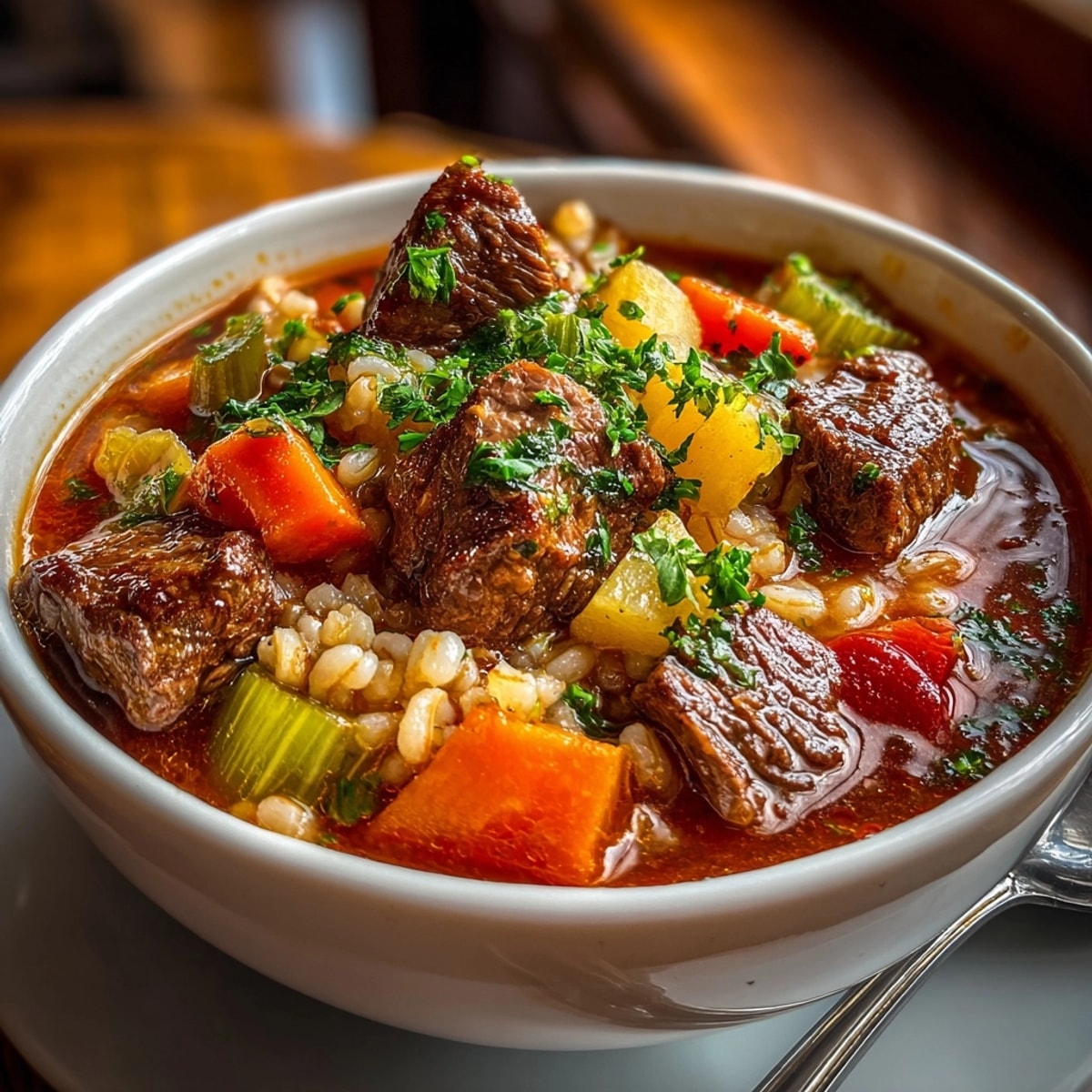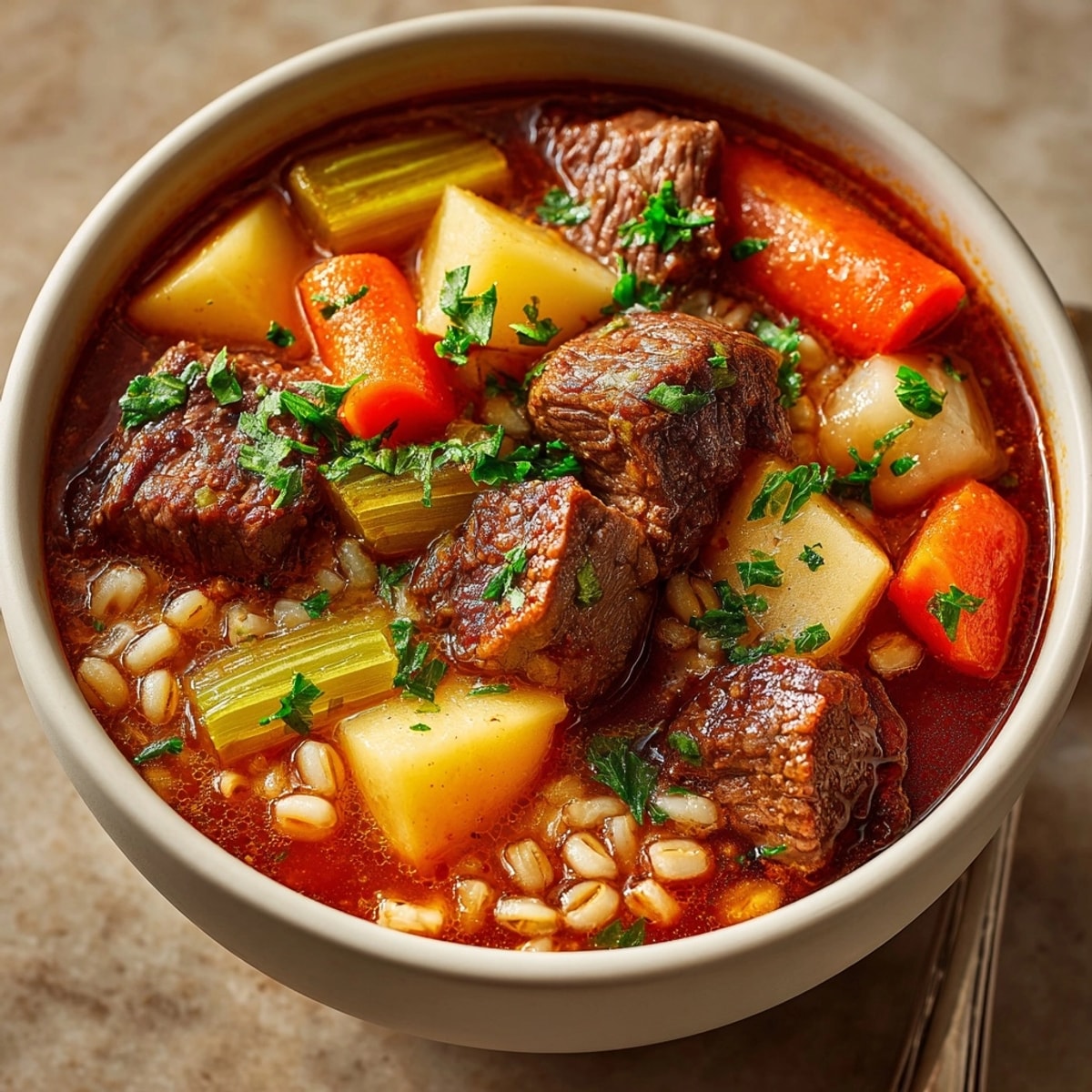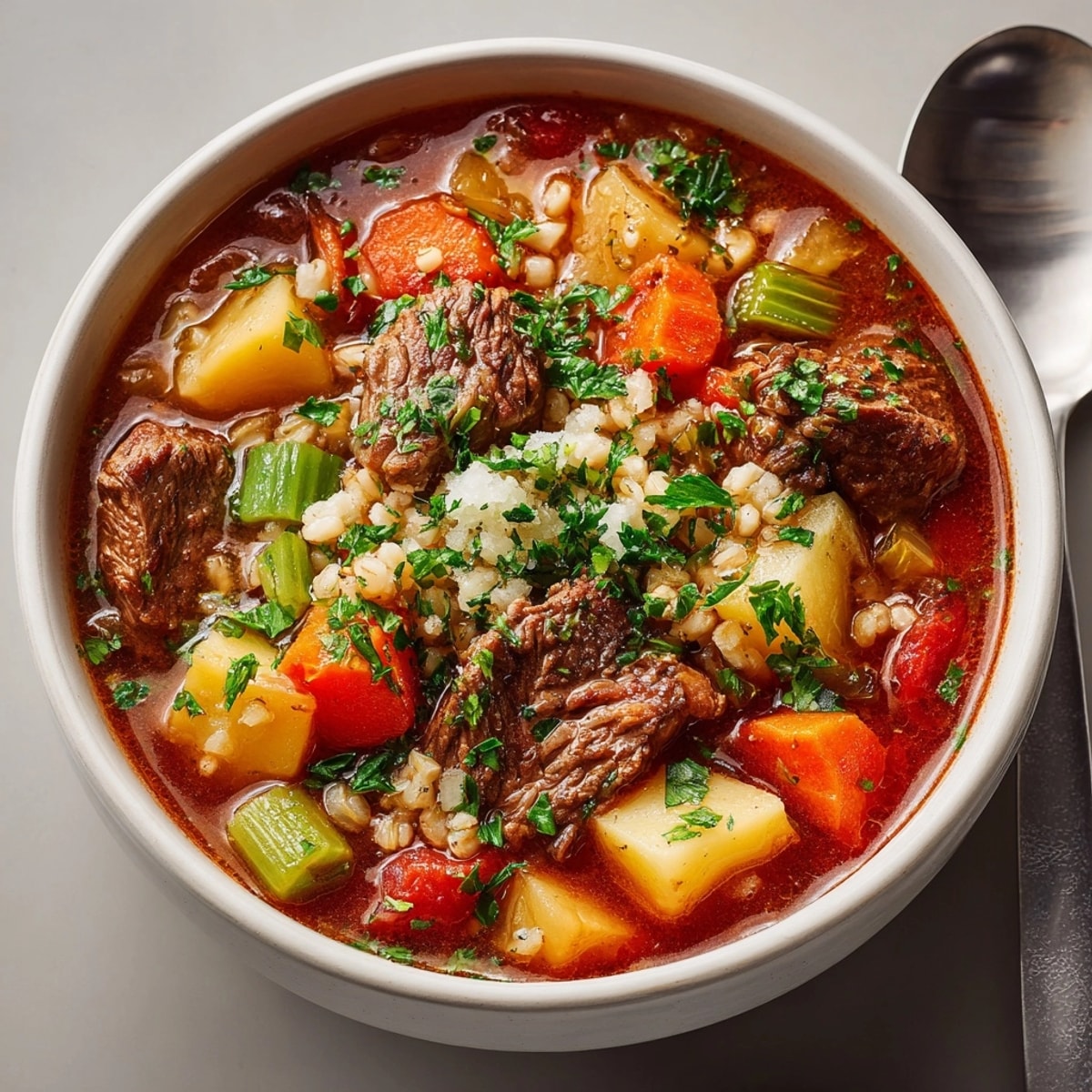 Save
Save This hearty beef and barley soup with root vegetables has been my cold-weather salvation for years. The combination of tender beef chunks, nutty barley, and sweet root vegetables creates a robust meal-in-a-bowl that satisfies deeply on chilly evenings.
I first developed this recipe during a particularly harsh winter when I needed something that would warm us from the inside out. Now it's become our Sunday tradition during the colder months, with my family gathering around steaming bowls as the perfect end to the weekend.
Ingredients
- beef stew meat cut into 2 cm cubes: 500 g Choose well-marbled chuck for the best flavor and tenderness
- onion diced: 1 large Forms the aromatic base of the soup
- garlic minced: 2 cloves Adds depth without overpowering
- carrots peeled and sliced: 2 Provides natural sweetness and beautiful color
- parsnips peeled and sliced: 2 Offers a slightly nutty sweetness that complements the beef
- celery stalks sliced: 2 Adds a subtle herbal note to the broth
- turnip peeled and diced: 1 medium Brings a slight peppery quality that balances the sweeter vegetables
- potato peeled and diced: 1 medium Helps thicken the soup naturally
- pearl barley rinsed: 100 g Look for pearl barley rather than quick-cooking varieties for better texture
- beef stock: 1.5 L Homemade is ideal but a good-quality store-bought works well too
- canned diced tomatoes undrained: 400 g The acidity brightens the rich flavors
- tomato paste: 2 tbsp Intensifies the umami qualities
- Worcestershire sauce: 1 tbsp Adds complex depth with minimal effort
- bay leaves: 2 Choose whole leaves rather than crushed for easier removal
- dried thyme: 1 tsp Provides earthy notes that complement beef beautifully
- dried rosemary: 1 tsp Adds aromatic pine notes
- Salt and freshly ground black pepper: to taste
- olive oil: 2 tbsp For browning the beef
- Chopped fresh parsley for garnish: optional
Instructions
- Brown the Beef:
- Heat olive oil in a large Dutch oven over medium-high heat until shimmering but not smoking. Add beef cubes in a single layer without overcrowding, working in batches if necessary. Allow them to develop a deep brown crust on all sides, about 5 minutes total. This caramelization creates rich flavor compounds that will infuse the entire soup. Transfer browned beef to a plate and set aside.
- Sauté the Aromatics:
- Reduce heat to medium and add diced onion and minced garlic to the same pot, using the residual fat. Cook until onions become translucent and slightly golden around the edges, about 3 minutes. Stir frequently to prevent the garlic from burning, which would add bitterness.
- Add Root Vegetables:
- Add the carrots, parsnips, celery, turnip, and potato to the pot. Cook for 5 minutes, stirring occasionally to coat the vegetables in the flavorful oil and onion mixture. This brief sautéing helps release the vegetables' flavors and gives them a head start on cooking.
- Combine and Simmer:
- Return the browned beef to the pot along with any accumulated juices. Add the rinsed pearl barley, beef stock, diced tomatoes with their juice, tomato paste, Worcestershire sauce, bay leaves, thyme, and rosemary. Stir thoroughly to combine all ingredients and scrape any browned bits from the bottom of the pot. These contain concentrated flavor that will enrich your broth.
- First Cooking Phase:
- Bring the mixture to a boil, then immediately reduce heat to low. Cover the pot with a tight-fitting lid and allow to simmer gently for 1 hour. During this phase, the beef begins to tenderize and the flavors start to meld. Stir occasionally to prevent the barley from sticking to the bottom.
- Final Cooking Phase:
- Remove the lid and continue simmering for an additional 30 minutes. This uncovered cooking allows some liquid to evaporate, concentrating the flavors and thickening the soup slightly. The beef should become fork-tender and the barley pleasantly chewy with a slight bite.
- Season and Finish:
- Taste the soup and adjust seasoning with salt and freshly ground black pepper as needed. Remember that flavors intensify as the soup sits, so season conservatively. Remove and discard the bay leaves, which have done their aromatic work but are not pleasant to eat.
- Serve:
- Ladle the hot soup into warmed bowls and garnish with freshly chopped parsley if desired. The bright green color and fresh flavor provide a lovely contrast to the rich, savory soup.
 Pin it
Pin it The humble turnip is actually my secret ingredient in this recipe. Most people overlook this root vegetable, but it adds a subtle peppery quality that elevates the entire soup. My grandmother always included turnips in her beef soups, and carrying on this tradition connects me to family cooking heritage that spans generations.
Storage and Make-Ahead Tips
This soup actually improves with time as the flavors continue to develop. Store cooled soup in airtight containers in the refrigerator for up to 4 days. The barley will continue to absorb liquid, so when reheating, you may need to add a splash of beef stock or water to achieve your preferred consistency. For longer storage, freeze portions in freezer-safe containers for up to 3 months. Thaw overnight in the refrigerator before reheating gently on the stovetop.
Smart Substitutions
If you cannot find certain ingredients or need to accommodate dietary preferences, there are several adaptable options. Replace beef with mushrooms for a vegetarian version, using vegetable stock instead of beef stock. Pearled farro or wheat berries can substitute for barley if needed, though cooking times may vary slightly. For a gluten-free option, omit the barley entirely and increase the potato quantity, or use buckwheat groats instead. The root vegetables are also flexible—sweet potatoes can replace regular potatoes, and rutabaga works wonderfully in place of turnip.
Serving Suggestions
This robust soup deserves accompaniments that complement its hearty nature. Serve alongside a crusty artisan bread or homemade cornbread for dipping into the flavorful broth. A simple green salad with a bright vinaigrette provides a refreshing contrast to the rich soup. For a more substantial meal, consider adding a cheese board featuring aged cheddar or gouda. In terms of beverages, a medium-bodied red wine like Merlot or Chianti pairs beautifully with the beef and root vegetable flavors.
Seasonal Adaptations
Winter Version: Add 2 tablespoons of red wine when sautéing vegetables for deeper flavor. Increase rosemary to 1.5 teaspoons for a more pronounced herbal note. Consider adding 1 cup of sliced mushrooms for earthiness.
Spring Variation: Replace half the beef stock with chicken stock for a lighter broth. Add 1 cup of fresh or frozen peas during the last 5 minutes of cooking. Garnish with fresh dill instead of parsley for bright spring flavor.
Fall Harvest: Incorporate 1 cup of diced butternut squash with the root vegetables. Add 1/4 teaspoon ground nutmeg for subtle warmth. Finish with a drizzle of good olive oil before serving.
 Pin it
Pin it This hearty soup is a comforting and satisfying meal, perfect for any cold evening. It's a dish that will warm you from the inside out and leave you with delicious leftovers.
Frequently Asked Questions
- → Can I substitute other root vegetables?
Yes, you can use rutabaga, sweet potato, or other seasonal roots to match your preference or availability.
- → How do I ensure the beef stays tender?
Browning the beef first and then slowly simmering it helps break down fibers, resulting in a melt-in-your-mouth texture.
- → Is it possible to make this in advance?
Absolutely. The flavors develop even more after a day in the fridge, so it’s ideal for meal prep or leftovers.
- → Can I use a slow cooker?
Yes, simply brown the beef and add all ingredients to the slow cooker, setting it on low for 6-8 hours until tender.
- → What can I serve on the side?
Crusty bread, a simple green salad, or pickled vegetables pair nicely to complement the hearty flavors.
- → How do I make this lighter?
Opt for lean beef cuts or increase the ratio of vegetables to reduce fat and calories without losing substance.